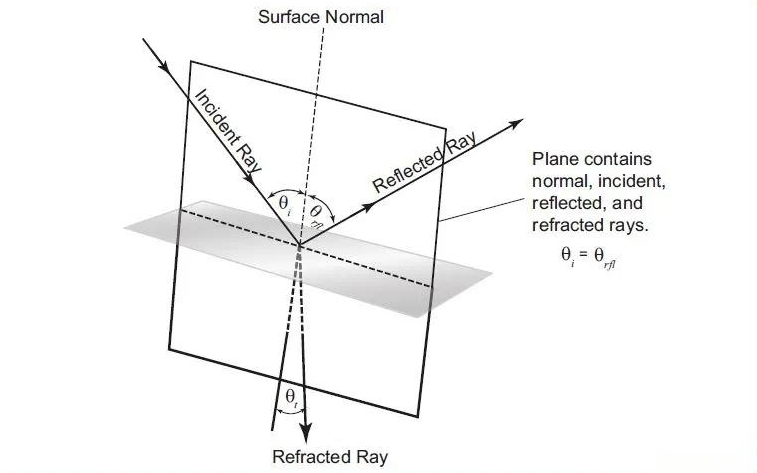Optical Mirrors in Hyperspectral Imaging Systems
Jan. 02, 2024
Push Scan Hyperspectral Imaging Principles
In this type of spectrometer, the front optics (reflector and objective) image a row of feature gates on the slit, and the detector array corresponding to the slit performs a self-scan to complete a one-dimensional spatial scan. The other dimension is accomplished by the motion of the carrier platform, i.e., two-dimensional spatial scanning is accomplished by solid-state self-scanning of the face array devices and forward motion of the flight platform. In addition, the slit is also the incident slit of the spectrometer, the spectrometer disperses the ground image on the incident slit uniformly to the focal plane detector, and the other dimension of the surface array detector completes the spectral scanning, i.e., the one dimension of the surface array device completes the spatial imaging, and the other dimension completes the scanning of the spectrum, and most of the sub-spectral devices are gratings and prisms as well.
An objective imaging spectrometer mainly consists of an incident slit, collimating lens, prism, grating and focusing lens, and and rectangular CCD detector constituting a spectral line imaging system. The spectrometer acquires a row of images of the target and disperses the light from the pixel points of each row of images onto the spectral axis. Each spectral image thus contains row pixels in the re-spatial axis and spectral pixels on the spectral axis.
Optical Mirrors
Optical Mirrors are one of the most commonly used optical components. Mirrors are used in small laboratory setups, industrial applications, and large optical systems. Mirrors utilize the principle of reflection to redirect, focus and collect light. Reflectors consist of a metal or dielectric film deposited directly onto a substrate (e.g., glass), and ordinary mirrors are coated on the rear surface of the glass. The reflective surface of an optical reflector may be affected by environmental conditions. Therefore, durability and damage resistance, as well as the extent to which the reflector reflects specific wavelengths, must be considered when selecting a reflector. This article describes the basic principles of reflection and discusses the important optical properties of mirrors.
Typically, when light reaches the interface between two media, part of the light is reflected into the original (incident) medium, and part of the light is transmitted and refracted into the second medium. In fact, there can be absorption of light in either medium, in this paper a non-absorbing medium is assumed. The direction of reflected light is determined by two laws: 1. the incident ray, the reflected ray, and the normal to the interface lie in the same plane; and 2. in the plane of incidence, the angle of incidence, θi, is equal to the angle of reflection, θrfl. Reflection can take place either on smooth surfaces such as the surface of mirrors (called specular reflection) or on rough, uneven surfaces (called diffuse reflection or scattering). Although both follow the same law of reflection, specular reflection causes light rays to reflect at the same angle as a whole, whereas diffuse reflection occurs at different angles on surfaces with random orientations. Thus, specular reflection enables the redirection of light.

The Optical Mirror's hyperspectral imaging system captures spectral information across a broad spectrum, extending beyond the range of human vision. It breaks down the light reflected from the object into its constituent wavelengths, allowing for comprehensive analysis of the reflected and absorbed light energies as a function of wavelength. This capability enables the identification of specific materials, detection of hidden objects, and evaluation of chemical compositions with unmatched accuracy and resolution.
Moreover, the Optical Mirror boasts exceptional optical performance, delivering high quality and distortion-free imaging. Its innovative design minimizes the impact of aberrations and ensures precise beam alignment, resulting in crisp and clear images. This level of accuracy is crucial in scientific research, medical diagnostics, and industrial inspections, where reliable and precise data is paramount.
The Optical Mirror is built to be rugged and durable, capable of withstanding harsh conditions and demanding environments. It is constructed using high-quality materials and undergoes rigorous testing to ensure its reliability and longevity. Our commitment to quality and reliability guarantees that the Optical Mirror will perform consistently, even in the most challenging settings.
In conclusion, the Optical Mirror is a game-changer in the field of optics, providing advanced beam deflection, folding, and hyperspectral imaging capabilities. Its versatility, precision, and ruggedness make it an indispensable tool for scientific research, medical diagnostics, aerospace engineering, and numerous other applications. With the Optical Mirror, researchers and engineers can push the boundaries of what is possible, enabling new discoveries and innovative solutions across a wide range of industries.
CLZ Optical Co., Ltd. has been manufacturing and trading optical components for many years such as optical domes, optical mirrors, optical windows, optical prisms ect.
We also could provide customized service, Utilization of various substrate materials, like sapphire, optical glass, fused silica and so on.
Please contact us free time if you have any needs.
Previous: Applications and Prospects of Spectroscopy
Next: THz Light Wave


















